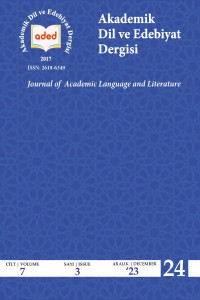Öz
The examples of the coastal writings belonging to the classical Turkish literature tradition so far are composed of poems written by Fennî (d. 1745), İzzet Efendi (d. 1797-98) and Derviş Hilmî Dede (d. 1183/1769-70). Therefore, the characteristics of the species were determined based on these few samples. The fact that all the available texts are dated to the 18th century suggests that the genre emerged in this period. One of the 18th-century poets, Bursalı Mü’minzâde Ahmed Hasîb, also has a work called Sâhil-nâme, which is not mentioned in the sources. Although the work of Hasîb bears the name of Sâhil-nâme, it shows some differences from other examples of the genre. Although the names of some towns on the shores of the Bosphorus are mentioned and depicted in this text as in others, the work differs from them in that it is a fortified narrative that develops around the plot. The non-manifested text of the verse in the journal within the Egyptian National Library, written in the form of a mesnevi verse and the pattern of “mef‘ûlü mefâ‘ilün fe‘ûlün”, consists of 96 couplets. However, considering some clues in the writing, it is thought that there is a deficiency of 138 couplets in Hasîb's Sâhil-nâme. In this study, part of the work, one of which is a manuscript and both of which are handwritten by the author, will be examined by comparing it with homogeneous texts as much as possible in terms of shape, content features as well as the place of the poem in the tradition will be determined and the transcribed text will be given. Thus, Hasîb's work titled Sahil-name will be included in the coastal literature, albeit incompletely.
Anahtar Kelimeler
Classical Turkish literature Bursalı Mü’minzâde Ahmed Hasîb sahilname verse story Istanbul Bosphorus.
Kaynakça
- Baysun, M.C. (1950). Boğaziçi iskelelerine dair bir kaside: İzzet Efendi’nin sahilnamesi. Türkiye Turing ve Otomobil Kurumu Belleteni, (103), 3-7.
- Demirkazık, H.İ. (2022). Sâhil-nâme (Fennî). Türk Edebiyatı Eserler Sözlüğü. http://tees.yesevi.edu.tr/madde-detay/sahil-name-fenni [Erişim tarihi: 25.08.2023]
- Kaplan, Y. (2015). Klasik Türk edebiyatında sahil-nâmeler ve Derviş Hilmî Dede’nin Sahil-nâmesi. Route Educational and Social Science Journal, 2(2), 148-159. http://dx.doi.org/10.17121/ressjournal.306 [Erişim tarihi: 15.08.2023]
- Kaplan, Y. (2021). Sâhil-nâme (Hilmî). Türk Edebiyatı Eserler Sözlüğü. http://tees.yesevi.edu.tr/madde-detay/sahil-name-hilmi [Erişim tarihi: 20.08.2023]
- Kaplan, Y. (2022). Sâhil-nâme (İzzet). Türk Edebiyatı Eserler Sözlüğü. http://tees.yesevi.edu.tr/madde-detay/sahil-name-izzet [Erişim tarihi: 10.08.2023]
- Öztoprak, N. (2004). Fennî ve İzzet Efendi’nin Sahilnamelerinde Üsküdar. Üsküdar Sempozyumu I Bildiriler (23-25 Mayıs 2003). Üsküdar Belediyesi Kültür Yayınları. 11-27.
- Öztoprak, N. (2004). Fennî ve İzzet Efendi’nin sahilnameleri ve bu sahilnamelerde Üsküdar. Türk Kültürü İncelemeleri Dergisi, (11), 111-148.
- Tansel, F. A. (1976). Divan şairlerimizden Fennî’nin Boğaziçi kıyılarını canladıran mesnevisi: Sâhilname. Belleten, 40(158), 331-346.
Öz
Klasik Türk edebiyatı geleneğine ait sahilnamelerin şimdiye kadar tespit edilen örnekleri; Fennî (ö. 1745), İzzet Efendi (ö. 1797-98) ve Derviş Hilmî Dede (ö. 1183/1769-70) tarafından yazılmış manzumelerden ibarettir. Dolayısıyla türün özellikleri bu az sayıdaki örneklerden hareketle belirlenmiştir. Eldeki metinlerin tamamının 18. yüzyıla tarihlenmesi türün bu dönemde ortaya çıktığını düşündürmektedir. 18. yüzyıl şairlerinden Bursalı Mü’minzâde Ahmed Hasîb’in de kaynaklarda adı geçmeyen Sâhil-nâme isimli bir eseri mevcuttur. Hasîb’in eseri Sâhil-nâme adını taşımakla birlikte türün diğer örneklerinden bazı farklılıklar göstermektedir. Diğerlerinde olduğu gibi bu metinde de Boğaziçi sahillerinde bulunan bazı beldelerin adları anılmış ve tasvirleri yapılmışsa da eser, olay örgüsü çevresinde gelişen tahkiyeli bir anlatı olması yönüyle onlardan ayrılmaktadır. Mesnevi nazım şekliyle ve aruzun “mef‘ûlü mefâ‘ilün fe‘ûlün” kalıbıyla yazılmış olan manzumenin Mısır Millî Kütüphanesindeki mecmuada yer alan müsvedde olmayan metni 96 beyitten meydana gelmektedir. Ancak yazmadaki bazı ipuçları göz önüne alındığında Hasîb’in Sâhil-nâme’sinde 138 beyitlik bir eksiklik olduğu düşünülmektedir. Bu çalışmada biri müsvedde ve her ikisi de müellif hattı olan eserin eldeki kısmı şekil ve içerik özellikleri bakımından mümkün olabildiği ölçüde türdeş metinlerle karşılaştırılarak incelenecek, manzumenin gelenek içerisindeki yeri tespit edilmeye çalışılacak ve transkripsiyonlu metni verilecektir. Böylece Hasîb’in Sâhil-nâme adlı eseri, eksik de olsa sahilname literatürüne kazandırılmış olacaktır.
Anahtar Kelimeler
Klasik Türk edebiyatı Bursalı Mü’minzâde Ahmed Hasîb sahilname manzum hikâye İstanbul Boğaziçi
Kaynakça
- Baysun, M.C. (1950). Boğaziçi iskelelerine dair bir kaside: İzzet Efendi’nin sahilnamesi. Türkiye Turing ve Otomobil Kurumu Belleteni, (103), 3-7.
- Demirkazık, H.İ. (2022). Sâhil-nâme (Fennî). Türk Edebiyatı Eserler Sözlüğü. http://tees.yesevi.edu.tr/madde-detay/sahil-name-fenni [Erişim tarihi: 25.08.2023]
- Kaplan, Y. (2015). Klasik Türk edebiyatında sahil-nâmeler ve Derviş Hilmî Dede’nin Sahil-nâmesi. Route Educational and Social Science Journal, 2(2), 148-159. http://dx.doi.org/10.17121/ressjournal.306 [Erişim tarihi: 15.08.2023]
- Kaplan, Y. (2021). Sâhil-nâme (Hilmî). Türk Edebiyatı Eserler Sözlüğü. http://tees.yesevi.edu.tr/madde-detay/sahil-name-hilmi [Erişim tarihi: 20.08.2023]
- Kaplan, Y. (2022). Sâhil-nâme (İzzet). Türk Edebiyatı Eserler Sözlüğü. http://tees.yesevi.edu.tr/madde-detay/sahil-name-izzet [Erişim tarihi: 10.08.2023]
- Öztoprak, N. (2004). Fennî ve İzzet Efendi’nin Sahilnamelerinde Üsküdar. Üsküdar Sempozyumu I Bildiriler (23-25 Mayıs 2003). Üsküdar Belediyesi Kültür Yayınları. 11-27.
- Öztoprak, N. (2004). Fennî ve İzzet Efendi’nin sahilnameleri ve bu sahilnamelerde Üsküdar. Türk Kültürü İncelemeleri Dergisi, (11), 111-148.
- Tansel, F. A. (1976). Divan şairlerimizden Fennî’nin Boğaziçi kıyılarını canladıran mesnevisi: Sâhilname. Belleten, 40(158), 331-346.
Ayrıntılar
| Birincil Dil | Türkçe |
|---|---|
| Konular | Osmanlı Sahası Klasik Türk Edebiyatı |
| Bölüm | Makaleler |
| Yazarlar | |
| Yayımlanma Tarihi | 30 Aralık 2023 |
| Gönderilme Tarihi | 15 Ekim 2023 |
| Kabul Tarihi | 6 Kasım 2023 |
| Yayımlandığı Sayı | Yıl 2023 Cilt: 7 Sayı: 3 |
This work is licensed under Attribution-NonCommercial 4.0 International


